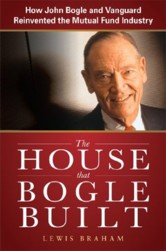

 In 1951, a Princeton University student wrote a thesis about the mutual fund industry. “Funds can make no claim to superiority over the investment averages,” wrote the scholar, who would go on to create the first index mutual fund some 25 years later. That young man, of course, was John Bogle, founder of The Vanguard Group and the subject of The House that Bogle Built
In 1951, a Princeton University student wrote a thesis about the mutual fund industry. “Funds can make no claim to superiority over the investment averages,” wrote the scholar, who would go on to create the first index mutual fund some 25 years later. That young man, of course, was John Bogle, founder of The Vanguard Group and the subject of The House that Bogle Built (McGraw-Hill Ryerson, 2011), a new biography by journalist Lewis Braham.
(McGraw-Hill Ryerson, 2011), a new biography by journalist Lewis Braham.
With the news that Vanguard has arrived in Canada, this book seems like timely summer reading. Not only does it paint a vivid portrait of one of the most important investor advocates of all time, but it also peers inside the unique organization he founded—a company that has been steadily drifting away from the vision of its first chairman.
“A long-term loser”
In a chapter called “The Devil’s Invention,” Braham explains what Bogle endured in 1976 when he launched the First Index Investment Trust, which would later become the Vanguard 500 Index Fund. The idea was so slow to catch on that it could not even afford to buy all the stocks in the S&P 500. Competitors mocked the very idea of a fund designed to match market returns—one called it “a formula for a solid, consistent, long-term loser.” Today that fund has $112 billion in assets, and once you account for survivorship bias, it has outperformed more than 90% percent of its competitors over the last quarter of a century.
Although Vanguard pioneered index investing and still manages some of the largest and best passive funds, the company has evolved since Bogle stepped down as chairman in 1996, after he received a heart transplant and appeared close to death. In one of the most personal chapters, Braham describes Bogle’s relationship with Jack Brennan, Vanguard’s CEO until 2009. Brennan was once a beloved protégé of Bogle’s, but the two men had a falling out and now appear to despise one another, though the specific reasons remain known only to their inner circles.
At least part of the tension must have arisen from Bogle’s almost ideological devotion to index mutual funds. Braham explains that in 1991 Bogle was approached by a product developer who had an idea for an index-tracking fund that would trade like a stock. “Bogle sent him packing, arguing that a tradable index fund would defeat the purpose of indexing,” he writes. That product would eventually be launched as the SPDR S&P 500 (SPY), nicknamed “Spiders,” one of the first and still one of the largest ETFs in the world.
Even 20 years later, Bogle remains critical of ETFs because of the way they encourage frequent trading. It’s opinions like these that can make him sound sanctimonious, and it’s perhaps not surprising that he’s had an uneasy relationship with the current Vanguard brass. About 30% of Vanguard’s assets are now in actively managed funds, for example, and the company markets itself heavily, something that makes Bogle cringe.
Saint and sinner
Braham’s portrait of Bogle is admiring, but not uncritical. The man they call “St. Jack” comes across as a bit of a media hound who loves the limelight, and he appears to have a towering ego. In one telling passing in the last chapter, Braham catalogues the honorary degrees and other accolades Bogle has received and quips, “Are you reading this, Jack?”
If there’s one element of the book I’d take issue with, it’s the second-last chapter, called “The Future of Indexing.” Here Braham looks at the flaws in traditional cap-weighted index funds. He spends a lot of time arguing in favour of fundamental indexing and even pines for an index fund that would make tactical shifts in asset allocation based on valuations. It’s odd to hear an author make comments like this after devoting so much space to describing just how well Bogle’s plain-vanilla index funds have stood the test of time.
But this is a small quibble—as are Bogle’s own imperfections. In an industry that has become the standard-bearer of greed and exploitation, he has been a tireless champion of the little guy for almost four decades. All investors owe Jack Bogle—now 82 and still going strong—an enormous debt of gratitude for the work he has done on their behalf. Lewis Braham’s candid portrait is fine chronicle of that legacy.












